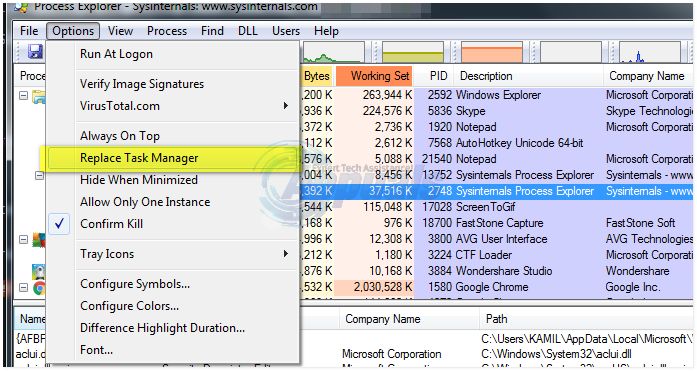

- PROCESS EXPLORER VS TASK MANAGER HOW TO
- PROCESS EXPLORER VS TASK MANAGER SOFTWARE
- PROCESS EXPLORER VS TASK MANAGER DOWNLOAD
- PROCESS EXPLORER VS TASK MANAGER FREE
If Procexp.exe is stored in a location where another user has no access. Click on the Services tab to monitor various values of. The Replace Task Manager is a global setting and affects all users on the computer. Click menu View > Show Unnamed Handles and Mappings. Click menu View > Lower Pane View > DLLs.
PROCESS EXPLORER VS TASK MANAGER HOW TO
Push Ctrl-Alt-Delete or right click on on the task bar, < start task manager and get process explorer! From the Task Manager tab, you can view the CPU and memory usage of each service and process. Process Explorer can show this information per-process : Here is how to get the above screen in Process Explorer : Click menu View > Show Lower Pane.It runs automatically whenever I boot up. The top one always shows you your currently active Processes. And part of the reason I say that is because I actually have Process Explorer as an auto-start entry on my two primary machines. Process Explorers two windows look like Task Managers Window but with much more information.
PROCESS EXPLORER VS TASK MANAGER FREE
A free utility that completely replaces Task Manager, there's no reason not to have and use procexp.
PROCESS EXPLORER VS TASK MANAGER SOFTWARE
Click start < Run (or the windows button + r) – type regedit in the box < OK < HKEY Local Machine < Software < Microsoft < Windows NT < Current Version < Image File Execution Options (right click) on debugger < Modify – in the text box type C:\Program Files\Sysinternals\procexp64.exe and close. Process Explorer is Task Manager on steroids. Click start, (or the windows button on your keyboard) < computer (right click) on program files < new (Right click) process explorer64 < copy to < computer < C: (or wherever your program files are stored) < Program files < Sysinternals < Copy and close.ĥ.
PROCESS EXPLORER VS TASK MANAGER DOWNLOAD
Download Process explorer at (remember where you put it)ģ. Download copy to\Move to at (Follow the directions given there and run the tweaks)Ģ. Process Explorer - The top window always shows a list of the currently active processes, including the names of their owning accounts, whereas the information. When editing the registry, do not edit HKEY_LOCAL_MACHINE\SOFTWARE\Microsoft\Windows NT\CurrentVersion\Image File Execution Options\procexp.exeġ.

Notes: Playing around in your registry can be hazardous to your computer! It is a process running on the Windows operating system and so it will show up as. If it’s worth the time to use one of these tools then it’s probably worth the time to use both, and you will commonly find yourself doing this.Unfortunately process explorer didn’t get placed in the programs folder when I ran it. Yes, the CPU usage if Windows Explorer (or File Explorer) can be visible. In daily use I often start with Process Explorer to find processes which are consuming a lot of system resources and then move to process monitor to dig deeper into these processes. Using it you can find out what files, DLLs, and registry keys particular processes have open and the CPU and memory usage of each. Process Explorer is considered to be a more advanced form of the Windows Task Manager. You can think of this as a combination of the old FileMon and RegMon tools with some basic diagnostic features. This tool will display information regarding the file system, registry, and the processes running on the system as they are occurring. Process Monitor is a real-time troubleshooting tool. I’ve written tips on both of these and frequently see people confuse them or even ask about the differences between the two. Windows Task Manager serves a purpose, but we recommend you replace it with Process Explorer for many reasons. For example, Windows Task Manager cant show loaded modules, threads, windows or. Process Monitor and Process Explorer both have a lot in common as they are both Microsoft Sysinternals tools designed to help you troubleshoot and debug processes on a Windows host. In Task Manager (and Sysinternals' Process Explorer) there are columns called 'I/O Reads', 'I/O Writes', 'I/O Read Bytes' and 'I/O Write Bytes'. YAPM offers lots of useful features that Windows Task Manager does not have.


 0 kommentar(er)
0 kommentar(er)
